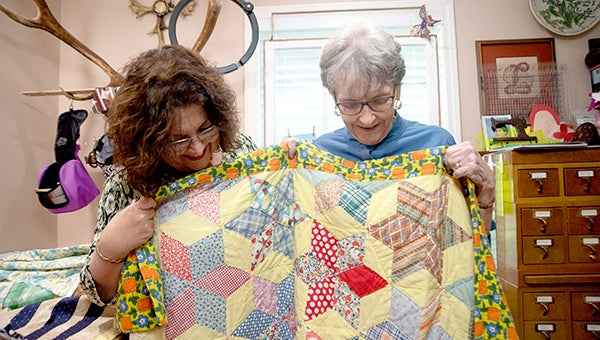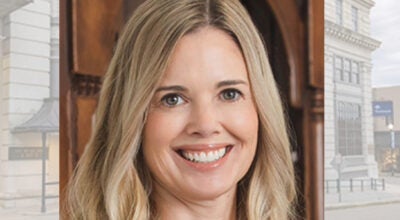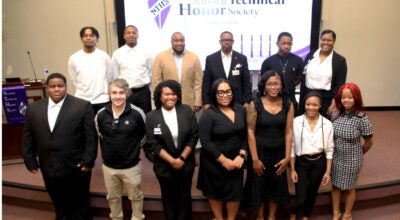Robyn Lea and her mother have a ‘patchwork partnership’
Published 5:49 pm Saturday, September 12, 2020

- Robyn Lea and her mother, Margot Martin. (Courtland Wells/The Vicksburg Post)
This article, written by Anna Kate Doiron, published in the September/October 2020 edition of Vicksburg Living. For more information on how to subscribe to Vicksburg’s premier lifestyles magazine, call 601-636-4545.
Robyn Lea’s love for quilting began only 10 years ago, but this family tradition dates back to the 1930s with her grandmother, Zaidee Dickinson.
Robyn has some of her grandmother’s quilts, which are now approaching a century in age. Most have worn over time, but with her newfound hobby, not only does Robyn make and design her own quilts, she has been repairing some of her grandmother’s creations.
Robyn began sewing in the third grade, but her interest in quilting grew when she was visiting her mother about 10 years ago. Once she started quilting, she said, she could not stop.
“I would come home from work and say, OK I’m going to sew for an hour then I’m going to go eat. I’d get up to go eat, and I’m not joking when I tell you it would be 4 a.m. in the morning,” before she would go to bed, Robyn said. “I became obsessed.”
Robyn has drawers full of new fabric for quilt-making, and some it is due in part to a friend in Michigan. Robyn laughs as she talks about this friend whose hobby is not quilting, but purchasing elaborate fabric.
“She has fabulous taste,” Robyn said.
Every few years, Robyn, who is a State Farm agent in Vicksburg, will fly to Michigan for a visit and return home with yards upon yards of material her friend collected.
Once, Robyn took an extra suitcase just for the fabric, but still wound up shipping four boxes of material back home.
Having an abundance of fabric would have been a luxury for Robyn’s grandmother.
“During the Depression, flour used to come in big sacks, and they also came in prints. We think some of this is from flour sacks,” Robyn said, as she pointed to pieces of fabric from a cherished quilt made by her grandmother almost 50 years ago.
“They wouldn’t throw anything away.”
Margot Martin, Robyn’s mother, also made quilts using recycled fabric.
Robyn showed off one that her mother had made out of clothing she wore as a child.
Like her daughter, Margot began sewing at an early age — sometimes, she admitted, even when it was not allowed.
Margot said when she was a young girl there was only one rule for her to follow when her parents would leave the house — no sewing.
But as soon as they were out the door, Margot would pull out her mother’s sewing machine and sew for hours.
Margot ultimately wound up making all of her clothes and Robyn’s until she was in high school.
The sewing machine used by Robyn’s grandmother and mother was a Singer Featherweight made on Nov. 27, 1934.
“I made everything Robyn ever wore on that machine,” Margot said.
The sewing machine has remained in the family. After a little research, Robyn said, it was discovered that it has become a “hot commodity” among collectors.
Since becoming passionate about quilting, Robyn said, she and her mother have collaborated on a variety of quilt projects.
One of those joint efforts was a few years back, when a college friend approached Robyn about making quilts for “nutritional orphans” in Guatemala.
Nutritional orphans are malnourished children whose parents cannot take care of them. As word spread about the need for quilts, others also offered to help in any way they could, Robyn said — whether it was by making quilts or simply donating fabric, which was delivered to her home.
“Somebody pulled into my driveway one night with a U-Haul (full of material),” Robyn said. “And I had to move everything out of my garage.”
Robyn said it took her about a month to sort through all of it.
“Nobody but me would have taken that much fabric,” she said.
In the end, more than 300 quilts were made for the children in Guatemala.
“We all felt so called to this task,” Robyn said.
She recalled one story she was told about a family who had received one of the quilts.
“They gave them (the children) a quilt to take home, so they could be warm. When a social worker went back, they (the family) had somehow attached it (the quilt) to the wall,” Robyn said. “The family was so proud because that was the first thing they had ever owned.”
Robyn said she enjoys making quilts for a purpose. Although it is a tedious, time-consuming task, it is nonetheless relaxing for both she and her mother. It can take up to a combined 80 hours to make one quilt — 40 to make the top and another 40 to quilt it.
Together, the women have made countless quilts for friends and family members.
“But I’ve never kept a quilt,” Robyn said.
In fact, the only two quilts in her home she made had originally been for someone else. One was for Mark Posey, who became her husband, and the other was for her mother-in-law, Betty Drake.
Betty had always complained of her legs being cold. After receiving the quilt, her legs were never cold again, and thus the quilt became known as “the magic quilt,” Robyn said.
Mark’s quilt was made as a “memory quilt” to honor a loved one.
Mark had lost his best friend, Tim Sumrall, to cancer and after his death, Sumrall’s wife, Marianne, had given him her late husband’s camouflage clothing.
Without him knowing, Robyn “cut up his best friend’s clothes,” which she then incorporated into the quilt.
Robyn took a big chance snipping away on the cherished clothing, but thankfully, things turned out well.
In talking about his quilt from Robyn, Mark teared up as he pointed to the varying styles of camouflage representative of the many decades the two men spent hunting together.
This precious memory quilt is used daily as it serves as the couple’s bed covering.
Robyn and Mark have been married three years, and in that time have embraced each other’s hobbies.
Mark talks about quilting as if he is the one who has enjoyed it for 10 years. And, on the flip side, since being introduced to hunting Robyn enjoyed several trips to Africa — one of them a honeymoon safari.
For Robyn, quilting has been so much more than a hobby.
It has been a way to help others as well as stay connected to family,
Margot said for her, too, quilting has been a way to carry on the family tradition. Quilting has kept her mother’s memory alive and it has been a way to bond with her daughter.
Mother and daughter have also learned to turn an everyday object into something with sentimental value.





